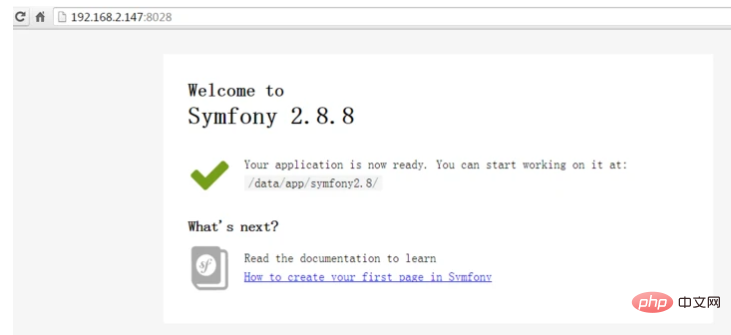Umgebungsbeschreibung
Betriebssystem
tony@ubuntu:~$ lsb_release -a No LSB modules are available. Distributor ID: Ubuntu Description: Ubuntu 14.04.2 LTS Release: 14.04 Codename: trusty
Symfony
symfony2.8
Installationsvorbereitung
Verwenden Sie apt-get zur Installation. apt-get 安装
PHP5.4
至少要有个PHP5.4的环境
nginx
web server 是少不了了
安装步骤
1.下载官方命令工具
sudo curl -LsS https://symfony.com/installer -o /usr/local/bin/symfony sudo chmod a+x /usr/local/bin/symfony
2.创建项目
这里执行项目创建时,会从官网下载源码包,执行完后就能在当前目录看到了
symfony new symfony2.8 2.8
这里我创建了一个新的项目叫symfony2.8, 最后的2.8(不是项目名字中的2.8) 是要下载指定的symfony2.8版本的源码,如果要下载的是其他版本, 修改一下接口
3.检测
在安装完后, symfony还会进行一些检测, 看看你的操作系统环境是否适合运行symfony, 按照提示将缺失的扩展安装(我安装了intl)或者将PHP的配置修改(我就改了时区),再执行
php symfony2.8/bin/symfony_requirements
再次检测是否通过(php 后面的文件就在新创建的项目中,我这里项目名是symfony2.8)
运行
symfony2.8' 自带的console(位置symfony2.8/bin/console)可以临时启动一个webserver,默认端口是8000,启动后,通过
At Mindestens Sie benötigen eine PHP5.4-Umgebung. Der Webserver ist unverzichtbar. Installationsschritte. 1. Laden Sie das offizielle Befehlstool herunter Das Paket kann von der offiziellen Website heruntergeladen werden. Nach der Ausführung können Sie es im aktuellen Verzeichnis sehen Name) dient zum Herunterladen des angegebenen Quellcodes der Symfony2.8-Version. Wenn Sie andere Versionen herunterladen möchten, ändern Sie die Schnittstelle3. Nach der Installation führt Symfony auch einige Tests durch, um festzustellen, ob Ihre Betriebssystemumgebung vorhanden ist ist zum Ausführen von Symfony geeignet. Folgen Sie werden aufgefordert, die fehlende Erweiterung zu installieren (ich habe
intl installiert) oder die PHP-Konfiguration zu ändern (ich habe die Zeitzone geändert) und dann
server {
listen 8028;
#server_name domain.tld www.domain.tld;
root /data/app/symfony2.8/web;
location / {
# try to serve file directly, fallback to app.php
try_files $uri /app.php$is_args$args;
}
# DEV
# This rule should only be placed on your development environment
# In production, don't include this and don't deploy app_dev.php or config.php
location ~ ^/(app_dev|config)\.php(/|$) {
fastcgi_pass 127.0.0.1:9000;
fastcgi_split_path_info ^(.+\.php)(/.*)$;
include fastcgi_params;
# When you are using symlinks to link the document root to the
# current version of your application, you should pass the real
# application path instead of the path to the symlink to PHP
# FPM.
# Otherwise, PHP's OPcache may not properly detect changes to
# your PHP files (see https://github.com/zendtech/ZendOptimizerPlus/issues/126
# for more information).
fastcgi_param SCRIPT_FILENAME $realpath_root$fastcgi_script_name;
fastcgi_param DOCUMENT_ROOT $realpath_root;
}
# PROD
location ~ ^/app\.php(/|$) {
fastcgi_pass unix:/var/run/php5-fpm.sock;
fastcgi_split_path_info ^(.+\.php)(/.*)$;
include fastcgi_params;
# When you are using symlinks to link the document root to the
# current version of your application, you should pass the real
# application path instead of the path to the symlink to PHP
# FPM.
# Otherwise, PHP's OPcache may not properly detect changes to
# your PHP files (see https://github.com/zendtech/ZendOptimizerPlus/issues/126
# for more information).
fastcgi_param SCRIPT_FILENAME $realpath_root$fastcgi_script_name;
fastcgi_param DOCUMENT_ROOT $realpath_root;
# Prevents URIs that include the front controller. This will 404:
# http://domain.tld/app.php/some-path
# Remove the internal directive to allow URIs like this
internal;
}
# return 404 for all other php files not matching the front controller
# this prevents access to other php files you don't want to be accessible.
location ~ \.php$ {
return 404;
}
error_log /data/log/nginx/symfony_error.log;
access_log /data/log/nginx/symfony_access.log;
}
symfony2.8' Die eingebaute Konsole (Standortsymfony2.8). 8/bin/console) kann vorübergehend gestartet werden. Ein Webserver, der Standardport ist 8000. Nach dem Start können Sie die Begrüßungsseite über http://localhost:8000`


























